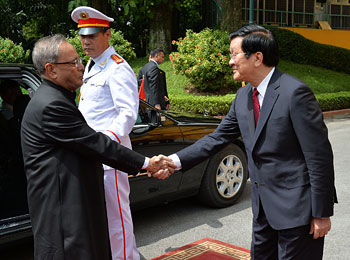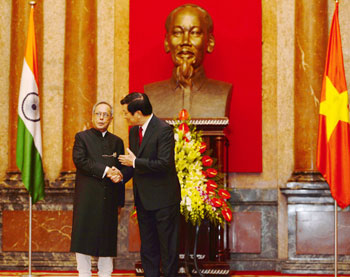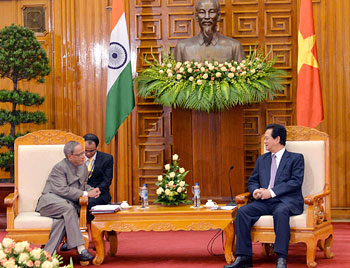INDIAN ARMED FORCES CHIEFS ON
OUR RELENTLESS AND FOCUSED PUBLISHING EFFORTS

SP Guide Publications puts forth a well compiled articulation of issues, pursuits and accomplishments of the Indian Army, over the years

I am confident that SP Guide Publications would continue to inform, inspire and influence.

My compliments to SP Guide Publications for informative and credible reportage on contemporary aerospace issues over the past six decades.
India — Vietnam: Growing proximity



While Chinese President’s visit (16th Sept) to Maldives resulted in the award of Male airport contract to a Chinese firm, which was earlier snatched from Indian company GMR, two years ago, Indians did not lag behind in the Chinese backyards when during Indian President Pranab Mukherjee’s visit the Indian government extended a US$ 100 million line of credit to Vietnam for acquiring patrol vessels, which actually will be used in monitoring the Chinese naval activities in South and East China Sea. Though the maritime area is a bone of contention between China and many South East Asian countries including Vietnam, India is taking a keen interest in ensuring that the sea remains an international waterways from where more than 55 percent of Indian maritime trade is conducted. Hence India’s move to develop deeper security partnership with Vietnam has strategic significance. Vietnam India relations goes back to Nehru-Ho Chi Minh era, when the two legendary leaders brought the two nations closer. Though India never took advantage of the enmity between Vietnam and China over territorial disputes, of late India’s interest in deepening the relations with the Chinese neighbor has grown because of India’s own national interests and insistence by the Vietnamese leaders to assist them in the sensitive defence technologies and weapon platforms besides assistance in petroleum exploration in the Vietnamese maritime area.
During the visit of President Pranab Mukherjee ( 14 — 17 September) the two countries released a joint communiqué signifying the extent of evolving defence partnerships between the two nations. The Joint Communique said, “US$ 100 million credit line would open new opportunities for defence cooperation and that details of what Vietnam would buy were being finalised.” With this India seems to be pushing ahead with a strategy to promote Indian arms exports to Vietnam, but India still seems to be fighting shy to export its Brahmos supersonic anti ship missile to Vietnam which the country wants desperately to deter the Chinese from threatening the Vietnamese maritime assets and forces. The Vietnamese officials have publicly asked India to supply them the Brahmos missile and when asked about this the Secretary East in the Ministry of External Affairs, Anil Wadhwa showed ignorance and said that these things are discussed between the two defence ministries. Interestingly the top MEA official did not deny the possible export of 290 kms Supersonic Brahmos missile to Vietnamese navy. According to Carl Thayer, an expert on Vietnam’s military at the Australian Defence Force Academy Vietnam was seeking India’s ship attack variants of the missile. Hanoi wants to acquire them as a deterrent against the Chinese offensive designs aimed at keeping the Vietnamese patrol ships out of the areas claimed by Vietnam. Referring to the disputed Spratlys island chain, Mr Thayer conjectured, "The Vietnamese do not want to be in a situation where they wake up one morning and discover the Chinese navy has surrounded one of its bases in the Spratlys.” According to strategic observers the supply of Indian Brahmos would prove to be a game changer in security calculus of the South and East China Sea. China would definitely be rattled by this level of security assistance to Vietnam.
Interestingly in the joint statement the two nations called for "freedom" of navigation in the South China Sea, a formulation which could irk China. This can be ensured if Vietnam is adequately equipped to deal with the Chinese aggressive behavior. In fact the joint statement was a subtle message to China which asserted that the freedom of navigation in the disputed waters of the South China Sea should not be "impeded" and called all the parties "concerned" to exercise restraint in this context.” The two countries had established strategic partnership in 2007 and since then there has been heavy flow of senior military and defence officials to each other’s capitals and military bases.
Chinese strategic observers have been keeping a regular watch on Indian naval activities on the Vietnamese coasts. Since Vietnam has awarded petroleum exploration rights to Indian company ONGC Videsh Ltd (OVL), Indian officials say that India needs to have forces in the region to safeguard these assets. India has been marking its naval presence in the area through cooperation between the armed forces of the two countries. India has been extending training facilities to the Vietnamese soldiers in Indian facilities and over last decade these relations have gone much deeper. However, it would be for the first time that India has extended such easy loan to Vietnam to acquire weapon systems from India.
Indian warships have been making regular forays to the Vietnamese naval bases and there are unconfirmed reports that Indian navy has been extended berthing facilities at the Nha Trang naval base of Vietnam in the South China Sea. The two countries had signed a Memorandum of Understanding in Defence cooperation way back in 1994 when the then Indian Prime Minister Narsimha Rao had visited Hanoi. Rao was the architect of India’s Look East Policy who realized the significance of developing closer defence relationship with China’s bete noire. China had the guts to launch a land attack on Vietnam in 1978 when the then Indian External Affairs Minister Atal Behari Vajpayee was in Beijing . He then protested Chinese move and cut short his visit to China. Since then Vietnam considers India as All Weather Friend, a term repeated for Vietnam during Pranab’s visit to Hanoi in his banquet speech . Incidentally Pakistan and China both refer to each other as the All Weather Friend.
Significantly Vietnam has handed over two more blocks for exploration in the Vietnamese sea which falls in the South China Sea and claimed by China. India and Vietnam has thus defied the Chinese dictates that India should avoid economic activities in the maritime area. Two years ago, while indirectly warning India, a Chinese spokesman Jiang Yu from the Foreign ministry was quoted as saying, “as for oil and gas exploration .... we are opposed to any country engaged in the waters under China’s jurisdiction. Interestingly the then navy Chief Admiral D K Joshi had responded on 23 Dec. 2012 to these indirect threats, “Although India was not a claimant in the dispute over territorial rights in the South China Sea it was prepared to act if necessary to protect its maritime and economic interests in the region.” This explains the rationale of growing defence relations between India and Vietnam which will be mutually complementary.
This is why President Mukherjee asserted, “Our Strategic Partnership has blossomed into a robust, mutually rewarding, multi-faceted relationship. Our co-operation at regional and multilateral fora constitutes one of the strong pillars of this Strategic Partnership. It has been reinforced by regular exchanges at the highest political level and the institutional mechanisms that we have created.” Later the Joint statement said, “The leaders agreed that defence and security cooperation was an important pillar of the strategic partnership between the two countries."
According to Anil Wadhwa, India and Vietnam have agreed to work for securing the sea lanes in their international waters to safeguard maritime security in the face of threats posed by terrorists and transnational crimes. We will work together to preserve the freedom of navigation in the seas that surround us then we can take this cooperation forward and we will cooperate in future as far as that aspect is concerned," To fulfill this commitment a strong defence and security partnership between the two Asian nations would be essential. President Mukherjee’s visit to Hanoi has given a big push to strengthen this.





